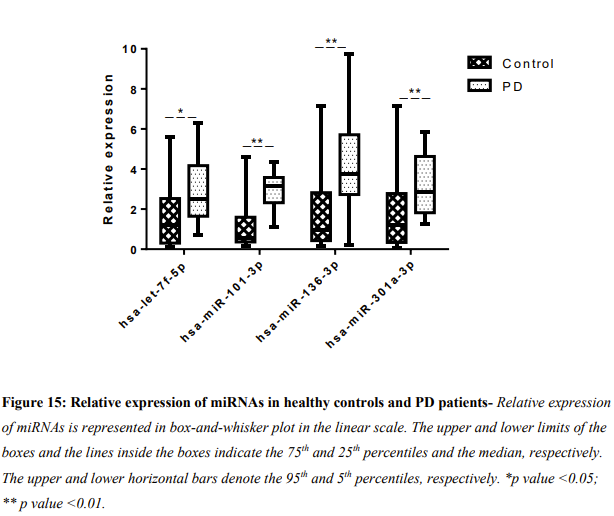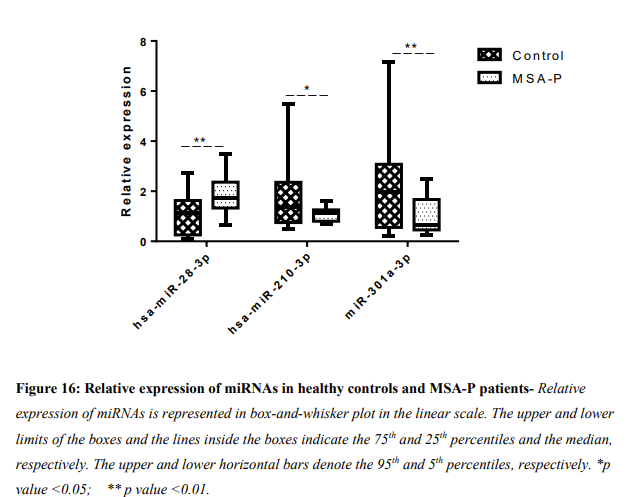Category: Parkinsonism, Atypical: MSA
Objective: Our objective was to identify differentially expressed, circulating miRNAs in Multiple System Atrophy-Parkinsonian type (MSA-P) and Parkinson’s disease (PD) which could serve as diagnostic biomarker.
Background: MSA-P and PD are sporadic progressive neurodegenerative diseases. The diagnosis relies mainly on clinical findings. Circulating microRNAs (miRNAs) have been proposed as diagnostic biomarkers in various neurodegenerative disorders.
Method: In our study, we conducted plasma miRNA profiling using reverse transcription quantitative polymerase chain reaction (RT-qPCR) arrays in patients diagnosed with MSA-P and PD, alongside cognitively normal controls matched for age and gender. We then proceeded to validate miRNAs that showed differential expression through quantitative PCR (qPCR). For each miRNA we selected, we determined its diagnostic sensitivity, specificity, and the area under the receiver operating characteristic curve (AUC).
Results: Fifty patients with PD, 28 with probable/possible MSA-P, and 25 age/ gender matched healthy controls were recruited. All the PD patients fulfilled UKPDS brain bank criteria, and MSA-P-patients fulfilled Gilman criteria. The mean age of patient with PD was 53.50±4.59 years, MSA-P was 54.00±8.81, and controls was 55.15±5.21 years. We found hsa-miR-28-3p miRNAs was overexpressed and hsa-miR-210-3p, and hsa-miR-301a-3p were decreased in MSA-P patients as compared to healthy controls. Four over-expressed miRNAs (hsa-let-7f-5p, hsa-miR-101-3p, hsa-miR-136-3p, and hsa-miR-301a-3p) were chosen for validation in 19 PD patients and 19 healthy controls. We found hsa-miR-101-3p and hsa-miR-136-3p, is under-expressed in MSA-P patients compared to PD patients. The results of validation cohort of 24 MSA-P patients compared to 19 PD patients was significant (p<0.05).
Conclusion: Plasma hsa-miR-28-3p, hsa-miR-210-3p, hsa-miR-301a-3p can be used to differentiate between MSA-P and healthy controls while hsa-miR-101-3p and hsa-miR-136-3p could be used to differentiate MSA-P and PD. However, large studies with replication of results will show their utility as a biomarker.
Fig 1. miRNA’s in healthy controls and PD
Fig 2. f miRNA’s in healthy controls and MSA-p
References: 1: Ramaswamy P, Christopher R, Pal PK, Yadav R. MicroRNAs to differentiate
Parkinsonian disorders: Advances in biomarkers and therapeutics. J Neurol Sci.
2018 Nov 15;394:26-37. doi: 10.1016/j.jns.2018.08.032.
2: Ramaswamy P, Christopher R, Kumar Pal P, Debnath M, Yadav R. Plasma microRNAs
as a Potential Biomarker for Identification of Progressive Supranuclear Palsy.
Diagnostics (Basel). 2022 May 11;12(5):1204. doi: 10.3390/diagnostics12051204.
3: Ramaswamy P, Yadav R, Pal PK, Christopher R. Clinical Application of
Circulating MicroRNAs in Parkinson’s Disease: The Challenges and Opportunities
as Diagnostic Biomarker. Ann Indian Acad Neurol. 2020 Jan-Feb;23(1):84-97. doi:
10.4103/aian.AIAN_440_19. Epub 2020 Jan 21.
4: Ramaswamy P, Yadav R, Pal PK, Christopher R. Can Circulating microRNAs
Identify Sudden Unexpected Death in Parkinson’s Disease ? Ann Indian Acad
Neurol. 2021 Mar-Apr;24(2):290-291. doi: 10.4103/aian.AIAN_292_20.
To cite this abstract in AMA style:
R. Yadav, P. Ramaswamy, PK. Pal, R. Christopher. Plasma MicroRNA Expression Profiling in patients with Multiple System Atrophy and Parkinson’s Disease [abstract]. Mov Disord. 2024; 39 (suppl 1). https://www.mdsabstracts.org/abstract/plasma-microrna-expression-profiling-in-patients-with-multiple-system-atrophy-and-parkinsons-disease/. Accessed April 19, 2025.« Back to 2024 International Congress
MDS Abstracts - https://www.mdsabstracts.org/abstract/plasma-microrna-expression-profiling-in-patients-with-multiple-system-atrophy-and-parkinsons-disease/


